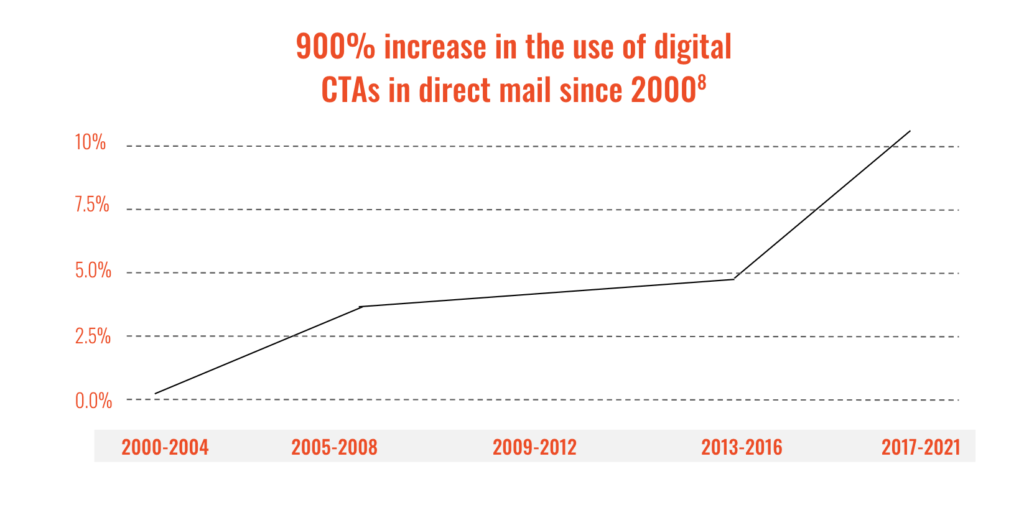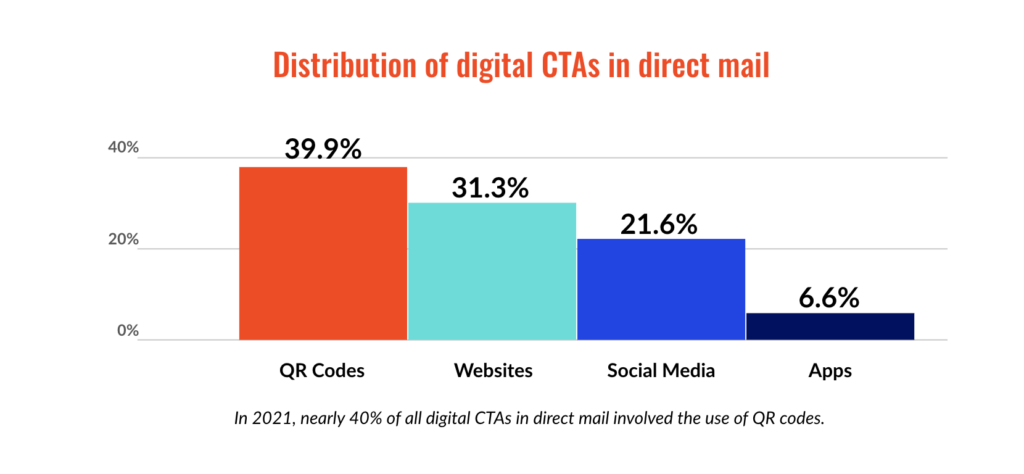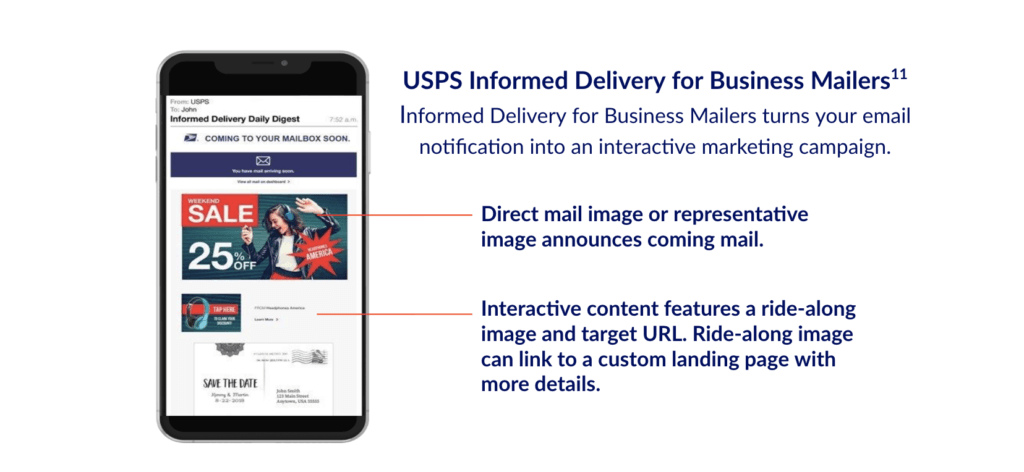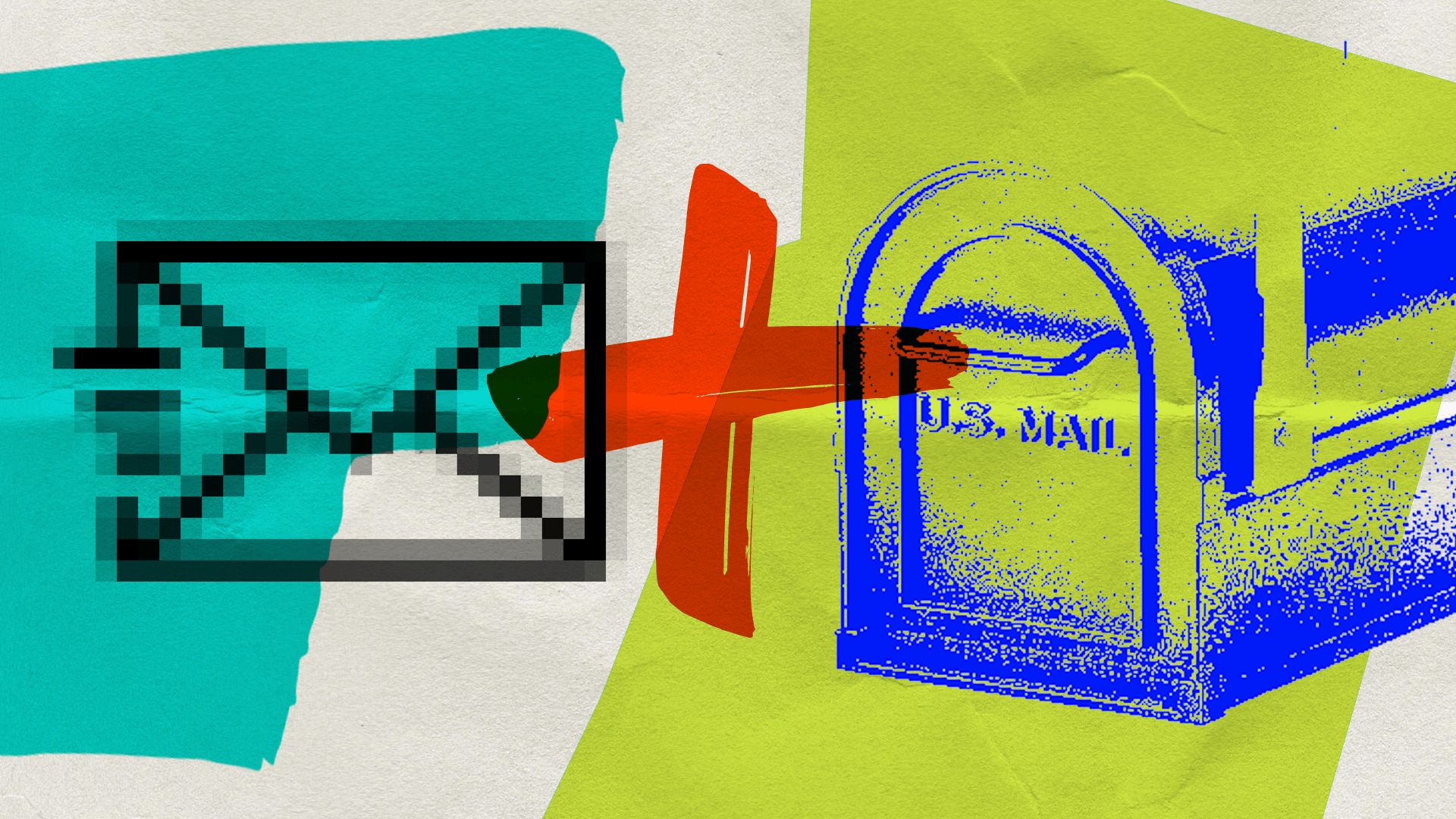How can we help you?
We want to hear from you. And it’s easy to reach us. Give us a shout at 844-886-2252, send us an email at hello@mediumgiant.co, visit our contact page, or fill out the form right here. You can expect a response within two business days.
What are you looking for?
The future of direct mail is digital
As a result of the recent pandemic, we’ve seen a seismic shift in buying behavior. Today, eight out of 10 U.S. consumers regularly shop online.1 Ecommerce sales are expected to top $1 trillion in 2022 and will continue to experience double-digit growth for years to come.2
This influx of digital shoppers has spurred a massive growth in the number of digital advertisers. Currently, there are more than 30 million U.S. businesses vying for people’s attention online.
30 million businesses.
There is good news, however, You can reach online shoppers without such fierce competition by using digitally powered direct mail. It incorporates digital engagement devices in printed pieces to drive prospects to online destinations.
With digitally powered direct mail, brands can bypass the digital clutter to achieve higher online conversion rates.
The case for digitally powered direct mail
Some numbers to consider:
- Eight out of 10 marketing managers report better results when adding direct mail to their digital marketing mix.5
- Online purchases and order size increase 28% when people receive direct mail.7
- 78% of consumers visit the brand’s website or search for info online after receiving direct mail.5
- 44% of online shoppers are 45-64, the demographic most likely to respond to direct mail.3
- 70% of consumers 18-35 — avid online shoppers — have made purchases based on a direct mail piece.6
Since 2000, the use of digital calls-to-action (CTAs) in direct mail has increased 900%, more than doubling in the last four years.8 And those CTAs involve much more than slapping a website URL on a direct mail piece.

Digitally powered direct mail engages people with CTAs designed to drive them to digital destinations. It creates a seamless transition from print to digital conversion points, integrating direct mail with unique digital content that provides additional offer detail, enhances the brand story, and supports online ordering.
Last year saw a wide range of industries — B2C and B2B — incorporating digital prompts into their direct mail; not surprisingly, retail stores led the way, with nearly 42%.8 Three industries that have always depended on direct mail to engage their audiences — nonprofits, health care, and finance — also use digital CTAs to a greater degree than ever before.8
Look for digitally powered direct mail to become standard practice across most industries in 2022.
Digitally powered direct mail generates meaningful online engagement
The average person is exposed to 6,000-10,000 digital ads every day.9 How do you generate meaningful engagement with them in the face of that type of competition?
Marketers are beginning to look offline for answers, specifically revisiting direct mail. On average, people receive just one direct mail piece per day – a far cry from the overstuffed mailboxes of the late 1990s.
Digitally powered direct mail engages prospects where there is less competition for the their attention. It then uses digital CTAs to drive consumers directly to online destinations, bypassing the millions of online advertisers vying for your prospects.
There are a number of ways to incorporate print-to-digital touchpoints into your marketing strategy. Two of the most effective are QR codes and informed delivery.
Download this article as a PDF
Our whitepaper dives into the benefits of incorporating direct mail into your marketing mix, including its unique ability to stand out in a crowded digital landscape, increase response rates, and drive ROI.
The comeback of the QR code
QR codes have made a huge comeback in recent years, particularly now that it’s no longer necessary to download an app to use the code. Widespread consumer acceptance of the revamped QR codes have made it the fastest-growing direct mail engagement device,10 and the leading CTA in digitally powered direct mail.
By promoting interaction and engagement through the mobile phone, QR codes provide instantaneous transitions from the tactile to the digital world.

The benefits of Informed Delivery®
In its most basic form, Informed Delivery gives USPS customers a free digital preview of what is arriving in their mailbox that day. These emails are sent to more than 41 million registered consumers nationwide and have a 64% open rate — more than four times higher than the typical email open rate.11
But the real benefit to businesses is the add-on service — Informed Delivery for Business Mailers — that enables marketers to replace grayscale images of the mailer with full-color representative images and supplemental content linked to online ordering.
With Informed Delivery, consumers can respond to your mailer before they ever remove it from the mailbox.

Digitally powered direct mail reengages prospects
You work hard to engage people online, only to have them disengage in the blink of an eye.
On average, consumers spend only 15 seconds on a web page.12 Shopping carts are abandoned 88% of the time.
Email is even worse: Nearly 79% of emails are deleted without opening. When people do open them, they spend an average of 10 seconds with the content, down 25% since the beginning of the pandemic.14
Although email open rates are up, both click-through rates and click-to-open rates are down,13 indicating that people are not engaging with email content. Attempts to reengage them through digital retargeting have been met with little success, achieving conversion rates averaging just .5%.
So how do you reengage people who’ve already abandoned your digital destination? By retargeting them with digitally powered direct mail.
One of the most effective uses of direct mail today is retargeting website visitors who’ve left before making a purchase. According to the Database Marketing Association, direct mail retargeting achieves response rates as high as 25%, dramatically higher than both digital retargeting and traditional acquisition direct mail.
For ecommerce sites, direct mail retargeting reduces cart abandonment by an average of 14%, recapturing thousands of dollars in lost revenue.11 In a recent USPS-sponsored study, marketers reported a 300-400% lift in conversion rates when targeting cart abandoners specifically.19
Direct mail retargeting can be applied to email as well. Email addresses can be matched to physical addresses, enabling you to retarget nonresponsive email recipients with a personalized direct mail piece.
How direct mail retargeting works
When a visitor lands on your website, their IP address is matched to a home location. This enables you to initiate a personalized direct mail piece based on the visitor’s interaction with your website. The exact location can be found roughly 40% of the time, so don’t expect to mail something to every prospect who comes to your site.
Using digital print-on-demand, the personalized mailer can arrive at the prospect’s home within a matter of days. The mailer engages people who aren’t responding to digital tactics, driving them back to the website.
Digitally powered direct mail facilitates in-depth selling and storytelling
Over the past decade, the amount of actual selling done in the typical direct mail piece has shrunk by 62%.8
That’s because postcards have become the format of preference for direct mail marketers. They’re faster, easier, and cheaper to produce than letterpacks. But when it comes to getting results, letterpacks with oversized envelopes get 18% higher response rates than postcards.17
62% reduction in sales messaging. 18% lower response rates.
Content is king, even in direct mail.
Digitally powered direct mail is the modern equivalent of the letterpack
Postcards are designed to create urgency. They grab your attention, scream out the offer, and urge you to take action. Letterpacks, on the other hand, offer selling in depth: an opportunity to tell an expanded story, to give people all the information they need to move closer to purchase.
Digitally powered direct mail combines the urgency of a postcard with the storytelling of a letterpack. Letters, inserts, and other engagement devices are replaced with landing pages designed to further engage audiences, enhance the sales message, and inspire people to take action. Digitally powered direct mail delivers letterpack results without the high cost.
Digitally powered direct mail pre-validates audience, messaging, and offer strategies
Marketers have a love-hate relationship with direct mail testing. They love the ability to improve results and reduce waste. But they hate the time, effort, and additional cost associated with testing audiences, offers, messaging, design, and format.
Digitally powered direct mail enables marketers to test critical aspects of their direct mail through social media and display advertising. It provides an imprecise but useful barometer to validate targeting, messaging, and offer strategies prior to committing to direct mail printing and mailing.
Looking for better direct mail results? Hire a digital agency.
A new breed of direct mail partners is emerging, combining proven direct mail expertise with digital savvy to drive better conversion rates for both offline and online tactics.
Medium Giant, a media and marketing company with strong ties to print media, provides comprehensive digitally powered direct mail services, from strategy to printing to digital integration. Let us show you how digitally powered direct mail can drive better conversion rates for you.
Sources
1 Statista
2 Nasdaq
3 https://whattheythink.com/articles/106889-using-print-reach-younger-consumers
4 https://on.emarketer.com/rs/867-SLG-901/images/Neustar-Commerce
5 Napco Research
6 Database Marketing Association
7 Infotrends
8 USPS/comScore
9 Who’s Mailing What
10 https://www.forbes.com/sites/forbesagencycouncil/2017/08/25/finding-brand-success-in-the-digital-world/?sh=84d95fd626e
11 https://www.statista.com/statistics/203513/usage-trands-of-social-media-platforms-in-marketing/
12 USPS
13 https://time.com/12933/what-you-think-you-know-about-the-web-is-wrong
14 https://www.campaignmonitor.com/resources/guides/email-marketing-benchmarks/
15 https://www.statista.com/statistics/1273288/time-spent-brand-emails/
16 Google Analytics
17 https://www.statista.com/statistics/1201901/most-visited-websites-worldwide-time-visi
18 https://docs.google.com/presentation/d/1rcapIVTV0Z1c2y3qHpKe89B3f9vhiALCALJScH_162M/edit#slide=id.g1170c7342fb_0_114
19 https://www.reddit.com/r/Entrepreneur/comments/hzikvl/how_this_letter_made_2_billion_dollars_for_the/
20 The Future of Direct Mail, USPS
21 Ipsos Research/ Neurons Inc. study
The future of direct mail is digital
As a result of the recent pandemic, we’ve seen a seismic shift in buying behavior. Today, eight out of 10 U.S. consumers regularly shop online.1 Ecommerce sales are expected to top $1 trillion in 2022 and will continue to experience double-digit growth for years to come.2
This influx of digital shoppers has spurred a massive growth in the number of digital advertisers. Currently, there are more than 30 million U.S. businesses vying for people’s attention online.
30 million businesses.
There is good news, however, You can reach online shoppers without such fierce competition by using digitally powered direct mail. It incorporates digital engagement devices in printed pieces to drive prospects to online destinations.
With digitally powered direct mail, brands can bypass the digital clutter to achieve higher online conversion rates.
The case for digitally powered direct mail
Some numbers to consider:
- Eight out of 10 marketing managers report better results when adding direct mail to their digital marketing mix.5
- Online purchases and order size increase 28% when people receive direct mail.7
- 78% of consumers visit the brand’s website or search for info online after receiving direct mail.5
- 44% of online shoppers are 45-64, the demographic most likely to respond to direct mail.3
- 70% of consumers 18-35 — avid online shoppers — have made purchases based on a direct mail piece.6
Since 2000, the use of digital calls-to-action (CTAs) in direct mail has increased 900%, more than doubling in the last four years.8 And those CTAs involve much more than slapping a website URL on a direct mail piece.

Digitally powered direct mail engages people with CTAs designed to drive them to digital destinations. It creates a seamless transition from print to digital conversion points, integrating direct mail with unique digital content that provides additional offer detail, enhances the brand story, and supports online ordering.
Last year saw a wide range of industries — B2C and B2B — incorporating digital prompts into their direct mail; not surprisingly, retail stores led the way, with nearly 42%.8 Three industries that have always depended on direct mail to engage their audiences — nonprofits, health care, and finance — also use digital CTAs to a greater degree than ever before.8
Look for digitally powered direct mail to become standard practice across most industries in 2022.
Digitally powered direct mail generates meaningful online engagement
The average person is exposed to 6,000-10,000 digital ads every day.9 How do you generate meaningful engagement with them in the face of that type of competition?
Marketers are beginning to look offline for answers, specifically revisiting direct mail. On average, people receive just one direct mail piece per day – a far cry from the overstuffed mailboxes of the late 1990s.
Digitally powered direct mail engages prospects where there is less competition for the their attention. It then uses digital CTAs to drive consumers directly to online destinations, bypassing the millions of online advertisers vying for your prospects.
There are a number of ways to incorporate print-to-digital touchpoints into your marketing strategy. Two of the most effective are QR codes and informed delivery.
Download this article as a PDF
Our whitepaper dives into the benefits of incorporating direct mail into your marketing mix, including its unique ability to stand out in a crowded digital landscape, increase response rates, and drive ROI.
The comeback of the QR code
QR codes have made a huge comeback in recent years, particularly now that it’s no longer necessary to download an app to use the code. Widespread consumer acceptance of the revamped QR codes have made it the fastest-growing direct mail engagement device,10 and the leading CTA in digitally powered direct mail.
By promoting interaction and engagement through the mobile phone, QR codes provide instantaneous transitions from the tactile to the digital world.

The benefits of Informed Delivery®
In its most basic form, Informed Delivery gives USPS customers a free digital preview of what is arriving in their mailbox that day. These emails are sent to more than 41 million registered consumers nationwide and have a 64% open rate — more than four times higher than the typical email open rate.11
But the real benefit to businesses is the add-on service — Informed Delivery for Business Mailers — that enables marketers to replace grayscale images of the mailer with full-color representative images and supplemental content linked to online ordering.
With Informed Delivery, consumers can respond to your mailer before they ever remove it from the mailbox.

Digitally powered direct mail reengages prospects
You work hard to engage people online, only to have them disengage in the blink of an eye.
On average, consumers spend only 15 seconds on a web page.12 Shopping carts are abandoned 88% of the time.
Email is even worse: Nearly 79% of emails are deleted without opening. When people do open them, they spend an average of 10 seconds with the content, down 25% since the beginning of the pandemic.14
Although email open rates are up, both click-through rates and click-to-open rates are down,13 indicating that people are not engaging with email content. Attempts to reengage them through digital retargeting have been met with little success, achieving conversion rates averaging just .5%.
So how do you reengage people who’ve already abandoned your digital destination? By retargeting them with digitally powered direct mail.
One of the most effective uses of direct mail today is retargeting website visitors who’ve left before making a purchase. According to the Database Marketing Association, direct mail retargeting achieves response rates as high as 25%, dramatically higher than both digital retargeting and traditional acquisition direct mail.
For ecommerce sites, direct mail retargeting reduces cart abandonment by an average of 14%, recapturing thousands of dollars in lost revenue.11 In a recent USPS-sponsored study, marketers reported a 300-400% lift in conversion rates when targeting cart abandoners specifically.19
Direct mail retargeting can be applied to email as well. Email addresses can be matched to physical addresses, enabling you to retarget nonresponsive email recipients with a personalized direct mail piece.
How direct mail retargeting works
When a visitor lands on your website, their IP address is matched to a home location. This enables you to initiate a personalized direct mail piece based on the visitor’s interaction with your website. The exact location can be found roughly 40% of the time, so don’t expect to mail something to every prospect who comes to your site.
Using digital print-on-demand, the personalized mailer can arrive at the prospect’s home within a matter of days. The mailer engages people who aren’t responding to digital tactics, driving them back to the website.
Digitally powered direct mail facilitates in-depth selling and storytelling
Over the past decade, the amount of actual selling done in the typical direct mail piece has shrunk by 62%.8
That’s because postcards have become the format of preference for direct mail marketers. They’re faster, easier, and cheaper to produce than letterpacks. But when it comes to getting results, letterpacks with oversized envelopes get 18% higher response rates than postcards.17
62% reduction in sales messaging. 18% lower response rates.
Content is king, even in direct mail.
Digitally powered direct mail is the modern equivalent of the letterpack
Postcards are designed to create urgency. They grab your attention, scream out the offer, and urge you to take action. Letterpacks, on the other hand, offer selling in depth: an opportunity to tell an expanded story, to give people all the information they need to move closer to purchase.
Digitally powered direct mail combines the urgency of a postcard with the storytelling of a letterpack. Letters, inserts, and other engagement devices are replaced with landing pages designed to further engage audiences, enhance the sales message, and inspire people to take action. Digitally powered direct mail delivers letterpack results without the high cost.
Digitally powered direct mail pre-validates audience, messaging, and offer strategies
Marketers have a love-hate relationship with direct mail testing. They love the ability to improve results and reduce waste. But they hate the time, effort, and additional cost associated with testing audiences, offers, messaging, design, and format.
Digitally powered direct mail enables marketers to test critical aspects of their direct mail through social media and display advertising. It provides an imprecise but useful barometer to validate targeting, messaging, and offer strategies prior to committing to direct mail printing and mailing.
Looking for better direct mail results? Hire a digital agency.
A new breed of direct mail partners is emerging, combining proven direct mail expertise with digital savvy to drive better conversion rates for both offline and online tactics.
Medium Giant, a media and marketing company with strong ties to print media, provides comprehensive digitally powered direct mail services, from strategy to printing to digital integration. Let us show you how digitally powered direct mail can drive better conversion rates for you.
Sources
1 Statista
2 Nasdaq
3 https://whattheythink.com/articles/106889-using-print-reach-younger-consumers
4 https://on.emarketer.com/rs/867-SLG-901/images/Neustar-Commerce
5 Napco Research
6 Database Marketing Association
7 Infotrends
8 USPS/comScore
9 Who’s Mailing What
10 https://www.forbes.com/sites/forbesagencycouncil/2017/08/25/finding-brand-success-in-the-digital-world/?sh=84d95fd626e
11 https://www.statista.com/statistics/203513/usage-trands-of-social-media-platforms-in-marketing/
12 USPS
13 https://time.com/12933/what-you-think-you-know-about-the-web-is-wrong
14 https://www.campaignmonitor.com/resources/guides/email-marketing-benchmarks/
15 https://www.statista.com/statistics/1273288/time-spent-brand-emails/
16 Google Analytics
17 https://www.statista.com/statistics/1201901/most-visited-websites-worldwide-time-visi
18 https://docs.google.com/presentation/d/1rcapIVTV0Z1c2y3qHpKe89B3f9vhiALCALJScH_162M/edit#slide=id.g1170c7342fb_0_114
19 https://www.reddit.com/r/Entrepreneur/comments/hzikvl/how_this_letter_made_2_billion_dollars_for_the/
20 The Future of Direct Mail, USPS
21 Ipsos Research/ Neurons Inc. study




